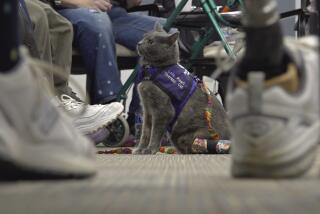Mentally Ill Children Find Help in Pets
- Share via
CAMARILLO — In a classroom at Camarillo State Hospital, an 11-year-old boy with sad, dark eyes sat in a corner, quietly petting his friend Echo, a golden retriever.
“Echo takes away my sad feelings,” said the boy, who is confined to a ward for mentally ill children. “And I’ve learned that animals have more feelings than I thought.”
Teachers and psychologists at the hospital, which has about 1,200 developmentally disabled and mentally ill patients, say they are using animals more and more in therapy.
Although there is no structured pet therapy program at Camarillo, the idea of allowing patients time to cuddle animals is quickly catching on. About half a dozen teachers and psychologists bring their pets to work every day, a practice encouraged by hospital officials. A few other employees have adopted cats that have wandered onto the spacious grounds.
“It’s something they can cuddle and love,” said Dee Press, a special education teacher who owns Echo. “A lot of the kids we have here have been abused mentally and physically. An animal is non-threatening.”
Employees stay close by when patients are with the animals.
“We’re very careful not to leave them alone. Some of the patients would kill the animals,” said Jerry Scheurn, coordinator of volunteer services at the hospital.
But no abuse has occurred, he said.
Press, who teaches children 8 through 13, said she is delighted with how her students react to her dog. She has been bringing Echo since the 7-year-old retriever was a puppy, she said, and she is always impressed with her students’ reactions.
“I’ve had kids who don’t talk very much,” Press said. “But sometimes when the kids are sad they will ask to spend a little time with Echo.”
Once a young boy was visibly upset when he came to class, but he refused to discuss his troubles. When Press allowed the child to pet Echo, the boy started to hug the dog and cry.
“I said, ‘Why don’t you tell Echo what’s wrong?’ ” Press said. The boy quietly explained that he was afraid his mother would forget to visit him at the hospital.
Camarillo hospital is not alone in using animals during psychiatric treatment. It is becoming a common practice in hospitals throughout the state, and Huntington Memorial Hospital in Pasadena even has a team of trained therapy dogs.
Westwood therapist Janet Ruckert describes “petcology”--the value of using pets to help people overcome their anxieties--in her book titled, “The Four-Footed Therapist.”
According to Ruckert, animals are natural therapists. By being warm and sympathetic listeners, they allow a patient to express deep emotions and needs.
The Camarillo hospital has a petting zoo with a goat and rabbits, but the children visit them sporadically. Therapists say patients relate better to cats and dogs because they usually are more affectionate.
Connie Westphal, a special education teacher at the hospital, said her students get upset if she doesn’t bring her dog Frankie, a dachshund, to class.
“They want to know where he is,” Westphal said. “They seemed to have bonded with him.”
A white and gray cat, often found under a tree outside the children’s ward, constantly receives attention.
“She does stuff that’s neat,” said a blond 11-year-old boy, scratching the cat behind the ears. “She rolls around in the grass and she catches mice. But the kids like her because she respects us. That’s important.”
More to Read
Sign up for Essential California
The most important California stories and recommendations in your inbox every morning.
You may occasionally receive promotional content from the Los Angeles Times.










